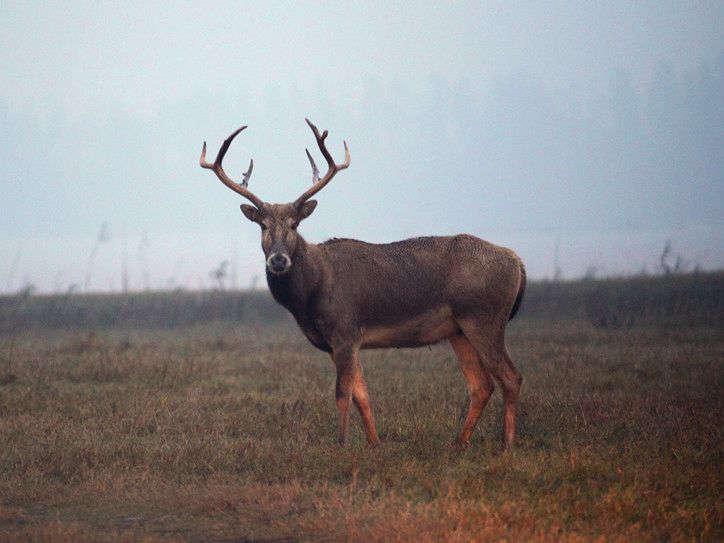
The photo taken on November 13, 2013 shows the Milu wandering at the Hubei Shishou Milu National Nature Reserve in Shishou city, central China's Hubei province. Photo: CRIENGLISH.com
The story of the Milu deer is one of a species that was nearly wiped out on its native Chinese soil when it was brought to the brink of extinction. Now, due to the efforts and attentive care of researchers, the Milu has improved in vitality at Hubei Shishou Milu National Nature Reserve.
CRI's Liu Yuanhui has the story from Shishou.
The Milu, or elk, is known as "sibuxiang" in Chinese, which means "four ways of being unalike" due to its unique appearance, with a horse's face, donkey's tail, cow-like hooves and stag's antlers.
Like many species that once roamed the earth, the Milu died out in its native China in the 1900s.
Cai Jiaqi, the head of the Publicity and Education Department under the Hubei Shishou Milu National Nature Reserve, states the history of the Milu's destiny.
"In 1865, French missionary Pere Armand David discovered the Milu at the former Imperial Hunting Park of the Qing dynasty in Beijing 300 years ago. David brought the bones and skins of the Milu to France. European zoologists found it was a new species, which belonged to an independent genus, creating quite a stir in the Western scientific community."
Cai says that in 1900, the hunting park was looted and the last group of Milu were carried off. Later, the 11th Duke of Bedford collected the remaining 18 deer across Europe and raised them near London.
However, it was not until the 1980s that over 50 Milu deer from Europe were introduced to China after decades abroad.
In 1991, an area besides Yangtze River in Shishou was selected as a nature reserve for Milu, due to its open waters, native woodlands, reed-beds, swamps and muddy areas, all preferred habitat conditions for the Milu.
And after over 20 years of hard work, the number of species living in the wild of the reserve grew from the 94 to about 1,000.
Cai says that even though the population has grown, protecting the Milu is still a matter of importance.
"Rescuing the Milu not only means we are protecting this kind of species, it is also good for sustaining the surrounding environment---the wetland, which is equals to a human's kidney, provides an important resource for the future. "
The Milu's personality stands in contrast to their large stature. They are shy and do not like to be disturbed. The best time to see these cute animals is in spring, when numerous kinds of grass turn green and many birds can be seen flying about in the wetlands.
Li Pengfei, a senior engineer at the Reserve, says that the Milu are very intelligent and an animal with a human nature as well.
"I once raised a few fawn Milu which were abandoned by their mothers for some reason. When they live with me, they have emotions. They didn't think they were animals, they thought they were a part of my family. When I ate, they came to eat; whenever i went, they just followed me. After raising them for two years, I brought them to the reserve, but they didn't want to join the wild Milu. They just stared at the herds of Milu like humans and thought they had no connection with these Milu."
Li says that Chinese people have regarded the Milu as an auspicious symbol for the carefree lives of the immortals for about 2,000 years. He is very proud to be the protector of the Milu.

The photo taken on November 13, 2013 shows the Milu wandering at the Hubei Shishou Milu National Nature Reserve in Shishou city, central China's Hubei province.
The photo taken on November 13, 2013 shows the Milu wandering at the Hubei Shishou Milu National Nature Reserve in Shishou city, central China's Hubei province.
|
|
||
 |
| Touched | Sympathetic | Bored | Angry | Amused | Sad | Happy | No comment |
Rhythm Media Group is a multi-media company, operating a US-based Chinese daily newspaper, The China Press, and the paper's website - uschinapress.com (which has mobile-app version), as well as a Beijing-based English website Sino-US.com. The group boasts 15 branch offices across the US, and a number of cultural centers focusing on culture-related business in the North America, Chinese mainland, Hong Kong and Taiwan.Launched in September 2012, the Sino-US.com is designed to serve as a bridge between China and the US, and to keep its readership inside or outside China better informed by providing news and insights on China's current affairs, culture, life, business, people and sports.
|
|